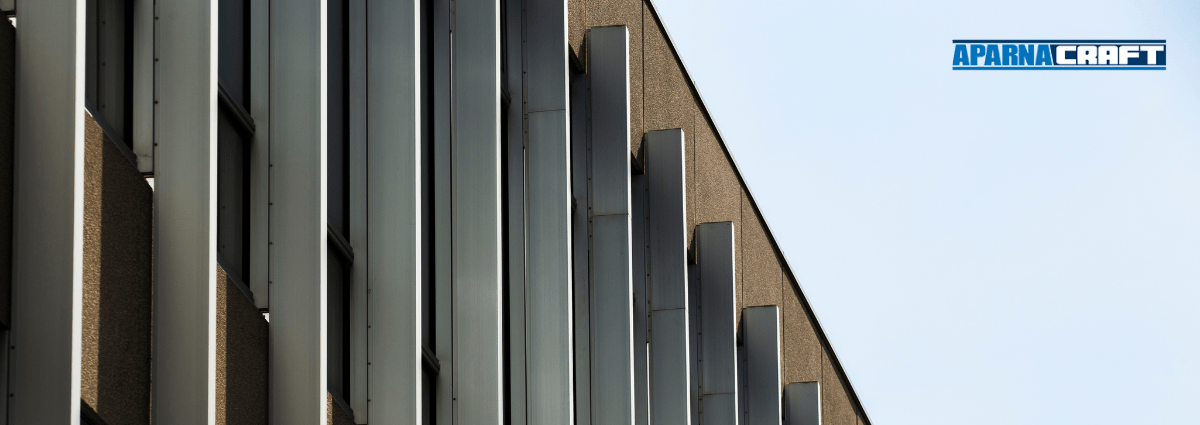The architectural landscape is continuously evolving, and one of the prominent trends in contemporary design is the vertical fins façade. This innovative concept has transformed the aesthetic and functional aspect of buildings, lending them a distinctive, modern edge. An integral part of modern architecture, the vertical fins façade is more than an aesthetic novelty. It serves a vital role in reducing solar heat gain, thereby enhancing the building’s performance.
Vertical fins are essentially external shading devices that are installed on the exterior of the building. These fins can be designed in various shapes, sizes, and materials, adding a unique visual element to the building’s façade. However, their primary function extends beyond aesthetics. They serve as a protective shield against the sun’s heat and glare, making the interior spaces more comfortable and energy-efficient.
Incorporating them in building design is a testament to the shift towards sustainable and eco-friendly architecture. This approach aligns with the global emphasis on energy conservation and the reduction of carbon footprint, given the increasing awareness of climate change.
Understanding Vertical Fin Façade Detail
The vertical fin façade detail is a critical aspect that determines the efficiency of these shading devices. The design, orientation, and material of the fins directly impact their performance in solar control and energy efficiency.
The design of the vertical fins façade involves careful planning and precision. The fins must be strategically positioned on the building’s façade to effectively block the sun’s rays. This involves a thorough understanding of the sun’s path and the building’s orientation, which influences the angle and spacing of the fins.
The material of the vertical fins is another critical detail. Materials with high reflectivity, such as aluminium and glass, are commonly used due to their ability to deflect sunlight. However, the choice of material also depends on other factors like the building’s design aesthetics, climatic conditions, and budget.
The Role of Vertical Fins Façade in Climate-responsive Architecture
Climate-responsive architecture is a design approach that takes into account the local climate to create comfortable and energy-efficient buildings. The vertical fins façade plays a crucial role in this approach, serving as an effective passive solar system.
By blocking the sun’s rays, vertical fins reduce solar heat gain, keeping interior spaces cool in hot climates. In contrast, in colder climates, the fins can be designed to allow more sunlight into the building, thereby increasing the building’s heat gain and reducing the need for artificial heating.
Moreover, vertical fins facilitate natural light penetration, which is a key aspect of climate-responsive architecture. This not only enhances the quality of indoor spaces but also reduces the reliance on artificial lighting, contributing to significant energy savings.
The Impact of Vertical Fins Façade on Solar Control
The vertical fins façade is a game-changer in solar control. By mitigating the impact of the sun’s heat, these shading devices significantly improve the thermal comfort of buildings.
Solar control is particularly crucial in buildings with large glass façades, as these are more susceptible to solar heat gain. The vertical fins façade can effectively shade these glass surfaces from the sun, reducing the heat gain and consequently, the cooling loads on the building. This not only makes the building’s occupants more comfortable but also reduces the need for air-conditioning, thus saving energy.
Furthermore, by reducing the sun’s glare, the vertical fins façade enhances visual comfort. This is particularly beneficial in office buildings, where excessive sunlight can cause discomfort and hinder productivity. By controlling the sun’s glare, vertical fins create a conducive work environment, improving occupant satisfaction and productivity.
How Vertical Fins Façade Contributes to Energy Efficiency
One of the significant advantages of the vertical fins façade is its contribution to energy efficiency. By reducing the dependence on artificial cooling and lighting, these shading devices significantly reduce energy consumption.
Firstly, by reducing solar heat gain, vertical fins decrease the cooling loads. This results in lower energy consumption by HVAC systems, contributing to substantial energy savings. Moreover, by allowing diffused natural light into the building, vertical fins reduce the need for artificial lighting during the day. This further reduces energy consumption, making the building more energy-efficient.
Furthermore, they can also contribute to renewable energy generation. Photovoltaic fins, equipped with solar panels, can harness solar energy, further enhancing the building’s energy efficiency.
Conclusion: The Significance of Vertical Fins Façade in Building Performance
In conclusion, the vertical fins façade is a revolutionary concept that has significantly impacted building performance. By offering effective solar control and contributing to energy efficiency, these shading devices are an integral part of sustainable, climate-responsive architecture.
The vertical fins façade is not just a design trend. It is a testament to the industry’s commitment to energy conservation and sustainability. By incorporating this concept, architects and designers can create buildings that are not only aesthetically appealing but also environmentally responsible and energy-efficient.


